White People Clothes and "Old Money Green"
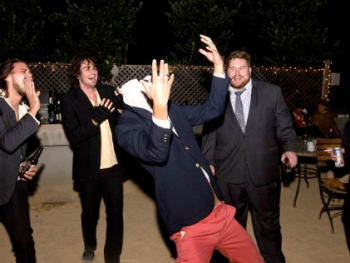
On the eve of my 28th birthday last month, I sat down to my computer prepared to purchase what my dad calls “proper pants.” Closer to 30 than I’d ever been before, I decided I’d like to enter the next couple of years owning at least a few pairs of trousers that weren’t denim, or at least not denim purchased at Uniqlo (one of the better reasons to live in New York, in my opinion).
I went to Polo’s web site, believing, as the ads have told me to, that Ralph Lauren is the lead purveyor of exactly that which I sought: pants! Classic, proper pants for American men who are through wearing only black denim to hide spilt beer but not through with having a certain interest in what messages their aesthetic sends to the world.
Still a believer in all clothes skinny, I clicked on the Slim-Fit Custom Chinos, tailored things described as “polished casual.” They looked to be snug in the ass like my old jeans but not something I’d be embarrassed to wear to an impromptu wedding or funeral. “Perfect, fuck it, I’m done,” I thought, dragging the little hand across the screen to the small square color swatches. I considered Aviator Navy and Polo Black. But I quickly abandoned both for a nice dark green — that is, until I clicked on the drop-down box and saw what specific kind of green I was about to order: “Old Money Green.”
I’d just wanted to buy a pair of pants. Instead, here I was being reminded that my grandfather was a butler and my grandmother a maid.
I was disappointed, though not necessarily surprised. Like any major clothing company, Polo hawks a lifestyle — or at least the dream of a lifestyle — just as much as it hawks shirts and belts. (For example, American Apparel, the general store for Midwestern kids with ambitions to do coke with Josh Hartnett in Lower East Side bathrooms, offers leggings in Night Fever Navy.) What was jarring, however, was how frequently these hints of old money airs turned up to pollute my shopping experience.
Over at J.Crew, a new arrival is the “plantation madras” button-down, a breezy, colorful shirt just in time for the annual thaw, not to mention a thing whose name I can’t help but associate with slavery. Of course, perhaps I’m being hypersensitive. Because not all plantations got fat off slave-labor and it’s a bit silly to necessarily associate the two. Then again, would anyone ever sell a “plantation bullwhip”? J. Peterman might. The company Seinfeld so often mocked seems more eager to revel in blue-blooded patriarchy than a Buckley sipping highballs on a yacht on Long Island Sound. Here’s the company’s description of a pair of its tweed slacks: “Did you know that Verdi wrote ‘Falstaff’ when he was 80? … Verdi, Walt Whitman, the Mellons. Hard workers from solid European stock. Just like these pants.” Well then! At that point, I say to hell with the subtlety; call them the Sorry, Darkie Breeches: “From solid European stock and for solid European stockholders.”
Thankfully, even more direct is J. Peterman’s “owner’s hat,” introduced thusly: “Some of us work on the plantation. Some of us own the plantation.”
I’m not naive. Having lived in New York and Los Angeles, I’m keenly aware that fashion has never been about inclusion — be it for the benefit of minorities (save gays), the poor or really anyone outside of a few major, expensive, Western cities. But lately, chic clothing appears to be trending toward privilege far more drastically than it ever has before. Take, for instance, Hedi Slimane’s Dior Homme line from years past. Though it was always prohibitively expensive, it was very often based on outfits New York’s hippest street rats pieced together from whatever they could barely afford or steal. And because it was grounded in a culture of poverty, the look seemed far more accessible — like an all-ages punk rock show — despite its price tag.
All this comes, oddly, after years of preppy and “white-seeming” major fashion brands (from Ralph Lauren to Vuitton) being propelled to success by black consumers. (“As hip-hoppers aspired to look like rich people, they took a keen interest in the preppy clothes that were very fashionable in the 1980s. This had a huge influence on a relatively new brand called Tommy Hilfiger,” wrote Henrik Vejlgaard in Anatomy of a Trend.)
Today, the look is classic Americana, exemplified best — at least where the Internet is concerned — by the tremendous success of fashion blogs like A Continuous Lean. ACL’s editor, an ostensibly very nice man named Michael, celebrates things like saddle shoes and Barbour jackets, and has said many times that he finds inspiration in things like Take Ivy, a photo book from the 1960s focused on the style of rich white men educated in the highest echelons of U.S. academia. Likewise, the Spade enterprise. Preppy plaids, professorial tweeds and bow ties festooned the models festooning the runways at New York’s most recent fashion week. Unlike their predecessors, who were often made up to look like Dee Dee Ramone and Kurt Cobain, working class heroes, these human coat hangers were mostly indistinguishable from the fashion people watching them: men and women who were born rich and will die rich, and who will look shiny all along the way.
I like Barbour jackets a lot, and Tod’s driving moccasins. I even like “Nantucket red” pants with a crisp white shirt and a blue blazer. But, as a person of color with no family crest of which to speak, I wonder if I should. It would be one thing if the current fashion trends were merely sentimental for grandpa’s favorite pair of shoes. But here, amidst the money greens and plantation nostalgia, it seems as if they’re also rooted in grandpa’s stunted cultural outlooks as well. I now see a sick irony in myself and kids in East New York wearing bow ties and sweater vests. Not new money kids, not old money kids, but no money kids who, apart from the slacks, look nothing like the Take Ivy boys everyone’s heralding, copying, designing for and listening to. To paraphrase one of my favorite poets, “I would go out tonight, but my ancestors were crushed under racial oppression for centuries.”
Cord Jefferson is a writer-editor living in Brooklyn. His work has appeared in National Geographic, GOOD, The Root and on MTV.
Slate Takes Contrarian Stand On Hand Sanitizers
Hand sanitizers don’t do jack to protect you from the flu, says Slate. Bonus fun fact: “In 1847, Hungarian doctor Ignaz Semmelweis discovered that washing one’s hands with chlorine between deliveries practically eliminated fatal infections among laboring women. (His colleagues ignored him and later committed him to a mental hospital, where he was beaten to death by guards.)”
Awfulness of 'Cop Out' Forces Critic to Turn on Critics
“This is the kind of critically bilious emetic I would ordinarily pass by, looking the other way. But at the screening for alleged critics I attended, one lady reviewer old enough to know better went into high-pitched squeals of shrieking hysterics every time the cops described in detail their excrement, flatulence and penis size.”
-Rex Reed, reviewing “Cop Out,” indicates subtly that he has had it with you people laughing about poop and farting and dicks.
Real America: The Gunmen Among Us
by Abe Sauer
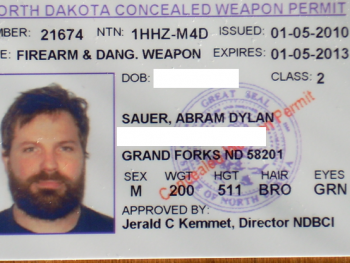
Guns kill people. That’s what they are meant to do. But do gun control laws kill people? Because they are generally not supposed to do that. Concealed carry permit holders claim that they do. To find out if they are correct, I became one of them.
Last year, U.S. states passed three times the number of laws that loosened controls on firearms than they passed laws restricting them. And you may have read a bit about forthcoming legislation around the country-referred to as “pro-gun measures”-on the front page of today’s New York Times. The result of the changes that have already taken place: a boom in permit applications-with at least nine million owners now licensed to secretly pack heat. Florida has seen the swiftest increase. Now, all but two states allow the concealed carry of a firearm.
Illinois is one of those two states; Wisconsin is the other. But maybe not for long. Cheese-headed governor Jim Doyle has shot down concealed carry supporters by swearing to veto any such legislation that crosses his desk. But Doyle will not be running for reelection this year. Republican contender Mark Neumann supports concealed carry-and it just might win him the election.
The concealed carry of weapons (CCW) elicits especially strong, often unreasonable, “debate.” Support for CCW can border on the pathological, while opposition is often specifically unsupported and inseparable from gun-control feelings in general. Drunk driving kills far more innocent people a year and is an unquestionably greater threat to society than those who lawfully carry a gun, yet liberals reserve far more scorn and ridicule for the latter. Meanwhile, maniacal CCW supporters can insist carrying a firearm is a duty of any real patriot serious about safety, like Arizona state senator Russell Pearce who, of proposed bill SB 1002, which proposed residents be allowed to conceal carry a firearm without any training or even a background check, said, “…our Founding Fathers expected it and demanded it.”
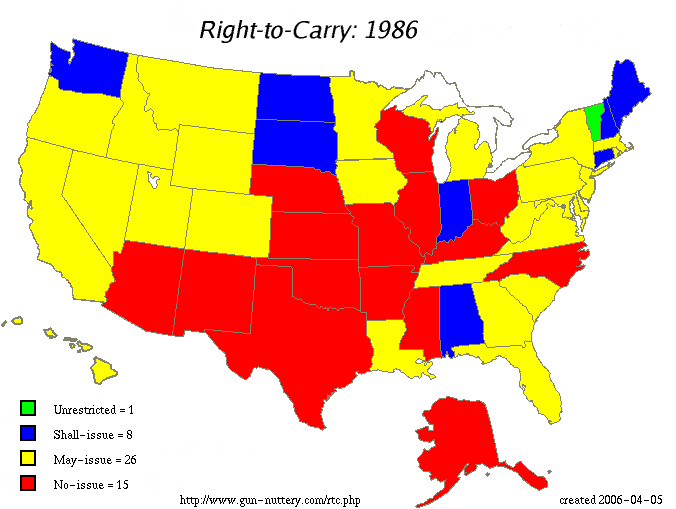
But many CCW advocates are genuine activists, no different from free speechers or PETA. And some of the tactics of the CCW movement are way more Critical Mass than NRA. This is especially true of “open carry.” Open carry is the practice of holstering a sidearm “old west” style, where it can be easily seen. Wesleyan professor of anthropology Charles Springwood has perfectly summed up the goal of the movement: they aim to “naturalize the presence of guns, which means that guns become ordinary, omnipresent, and expected. Over time, the gun becomes a symbol of ordinary personhood.”
And in this omnipresence, open carry offers a deterrent that CCW does not-which is that crimes will become less common if criminals observe many around them are armed.
The official position of the Brady Campaign to Prevent Gun Violence is that “The open carrying of firearms in public places is inherently threatening and intimidating, and poses risks to those nearby, to law enforcement and to the community. For example, when open carry has occurred in retail stores, other customers quickly become alarmed and the police often are called to the scene, creating a volatile and potentially dangerous situation.”
This assumes that people are unfamiliar with the law allowing open carry. Should open carry become more common, it seems safe to assume that over time such instances would decline (along with the volatility of such “potentially dangerous situations”). And in communities where open carry advocates have been active, some police dispatchers have begun asking callers whether the person reported with the gun is acting threatening or if the gun is just securely holstered.
Mike Stollenwerk, co-founder of OpenCarry.org, told me that open carry has become more popular “because almost all gun owners want the freedom to choose their method of carry. But this depends on the individual and what scenario she thinks might happen to her, deterrence verses freedom to choose when to let an attacker know she is armed are the main tactical issues. But social issues arise as well. There is plenty of gun bigotry in the USA and many gun owners wish to avoid that by concealing. At OpenCarry.org we think that it’s time gun ownership came out of the closet and the best way to do this is for normal Americans to openly carry properly holstered handguns in daily life. In the end, the debate over form of carry is like that old Miller Lite commercial-less filling, tastes great; gun owners want their freedom to choose.”
But in many states with tough or no CCW laws (California, Wisconsin), open carry offers CCW activists a way to make a point: Give us a CCW law or get used to seeing guns. Not surprisingly, our society is not ready to see guns that are not on the TV.
After Ohio activists hosted numerous open carry gatherings, including one in front of the governor’s mansion, the state ended its 145-year CCW ban. This is what advocates in Wisconsin are aiming for. In the absence of a CCW law, an emboldened open carry movement has produced several legal black eyes for the police, who have a tendency to get a little testosterony when they observe an openly carried firearm. In one instance, a cop joked about shooting open carriers. After Wisconsin’s attorney general said that open carry was legal in the state, Milwaukee’s chief of police enraged everyone by saying “we’ll put them on the ground, take the gun away and then decide whether you have a right to carry it.” And then his force was sued for doing just that.
* * *
There are no advantages to Open Carry. And there are many disadvantages. Open carry is just that. Everybody knows you have a gun, including the bad guys. This can make you a target of someone planning on committing a crime. It just reduces options. Visualize a 7–11 scenario where the bad guy comes in to rob the place. He sees your gun, you are now a priority target that must be dealt with before he can proceed with his original plan… add to that, you may, because you are concentrating on a can of V8, not even be aware that he is there… Do you see a potential problem there?
That is William Schmitz, a certified multi-state firearm instructor and the chairman of Wisconsin Concealed Carry Association. Schmitz spoke with me about CCW in Wisconsin and elsewhere.
A concealed carry permit is not the ticket to inevitable shooting crime. But while liberals often unfairly lump CCW permit holders in with pro-assault weapon extremists, many CCW proponents do their cause no favors by denying a reasonable boundary between a licensed person carrying a small handgun for personal protection and an untrained nincompoop amassing an arsenal of weapons designed solely for war. The group Wisconsin Gun Owners is the perfect embodiment of this problem; the group’s website boasts a tactical assault rifle superimposed over the state itself on a banner just above a terrorism-esque color-coded “gun control threat level” meter (always “high”). And this frames the biggest issue facing CCW.
“The perception of CCW is really the biggest issue. People who don’t know what concealed carry is all about perceive it to be dangerous. They have no experience with it,” Schmitz said. He claims that a lot of this has to do with a media environment that is largely loathe to print stories of instances where a concealed firearm saved a life or prevented a crime. And he’s not completely wrong. The uncomfortable truth for those who are against the practice is that there are many instances of CCW doing exactly what CCW-proponents claim.

A larger part of CCWs perception problem may be CCW holders themselves. Many liberals judge CCW advocates by their language alone. For example, in my talks with Schmitz, he talked about “bad guys,” “target rich environments” and “tactical situations.” My reaction is to roll my eyes. For those who never use it, this lingo and posturing can come across as comical and creates an instant disconnect. It seems those who exercise CCW permits often enter a whole new culture where the very act of walking around with a gun comes to consume them. For the outsider, it seems a culture of constant paranoia, not just regarding the potential for having to use the weapon, but of just having the weapon at all. This phenomenon appears universal, as those that one would expect to be more nuanced about gun ownership display the same behavior. This includes groups like Pink Pistols, a gay CCW-advocacy group.
After pouring over literature, message boards and talking with proponents, it’s challenging not to see those who carry a handgun as dweeby 15-year-old kids who carry a condom everywhere. They’re “prepared,” “just in case,” because “you never know,” “it could happen.” Equally, they both seem to fantasize about situations when they might actually use it. It’s this way that some CCWers emphasize rare or unlikely “tactical” scenarios that will never materialize that make it a test for a rational person to take the movement seriously. And yet, the effort should be taken seriously because the driving force behind much of it is a genuine desire to be safe and protect oneself because “the system” is failing at this responsibility (see Pink Pistols above).
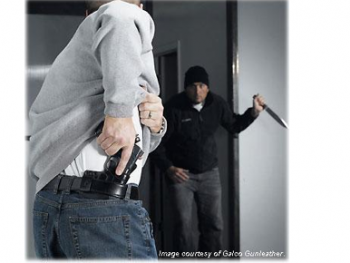
Schmitz generally agreed with this assessment about the movement’s language, saying that words like “tactical” are taken negatively. But, he said, “In the broader picture, however, everything is tactical. From the board room to the bedroom. Tactical, in reality, means nothing more than an assessment of probable outcome. However folks, many times, do not look at [this].”
For those sympathetic to the cause, CCW faces some non-perception-based, honest-to-god real-scenario hard questions. Maybe the hardest of which is: suppose many people at one of America’s more iconic shootings (be it Virginia Tech or the Nebraska Mall) were concealed carrying. While it is true that these armed citizens might have quickly ended the situation by shooting the shooter, it is just as likely that, in the mass confusion of “a shooter!” everyone would be aiming at (if not shooting at) everyone else with a drawn weapon.
I posed the question to Schmitz. “Way too many scenarios to go into all here,” he said. “Suffice to say this: you have never heard of an attacker accosting an armed group. The fact that a certain percentage may be armed will tend to reduce the occurrence of these incidents. Setting up a gun free zone is the same as setting up a safe, for the active shooter, target rich environment.”
Whether or not that answers the nightmare CCW hypothetical is unclear. But one thing Schmitz can agree on is training. Even as pro-gun rights as Schmitz is, he cannot get behind movements such as the “Vermont style” movement.
Disturbingly, “Vermont-style” right-to-carry, which allows citizens to carry a gun with no permit, fee or any kind of waiting period or background check whatsoever, are growing in popularity. “There are many reasons for a state to adopt [this] genuine right to carry law,” claim proponents. One reason: “A comprehensive national study in 1996 determined that violent crime fell after states made it legal to carry concealed firearms.”
And you can’t argue with numbers, right? Right? That “comprehensive” study? It was done by John Lott. Spend some time in the gun debate and you will undoubtedly get to know John Lott’s gun-rights research. You might also get to know Mary Rosh, the fictional Wharton School student Lott pretended to be to defend and justify his work on numerous online reviews and message boards. A murderers’ row of experts, including Yale Law School professors and the authors of “Freakonomics” (who Lott sued for defamation), have shot holes in Lott’s work. (On the Freakonomics blog, they wrote of one of Lott’s studies that “Virtually nothing in this paper is correct.”) Still Lott is still regularly used not only by the NRA and concealed carry proponents, but also by state legislators seeking to convince colleagues to pass increasingly permissive gun bills.
This tragic adherence to any data regardless of accuracy in an attempt to make a point is tragic. Still it doesn’t mean pro-CCW arguments are bunk. The concealed-carry debate is rife with misinformation on both sides. Misinterpretation of data and assumptions made and press-released to the public, much of it based on typical correlation/causation fallacies, is commonplace. And too often, passions of CCW are inseparable, (again, by both sides) from the whole expansive range of gun control and gun freedoms debates, which aren’t really debates at all.
* * *
To find out just how educated a CCW permit-holder must be, I went through the process to get my North Dakota concealed carry permit.

The only weapon I’ve ever owned is a 1986 Bo Jackson-signed Louisville Slugger. But growing up on a farm and with several gun-obsessed friends, I’m familiar with guns. With rifle-style firearms I would rate myself “intermediate.” But with handguns, I’m about a “total beginner.” While I’ve fired a revolver, I have never even handled, for six seconds, a semi-automatic pistol.
I tested for the easiest North Dakota permit to get, a class 2. And, oh, was it ever easy.
For most of its statehood, North Dakota allowed no commerce of any kind to be conducted on Sunday. These “blue laws” largely disappeared in the 1980s. But not fully in Grand Forks, where several are still observed. (This is why Home Depot is closed until after noon on Sundays.) So the fact that I took the a test to exercise my constitutional rights on a Sunday at 9:00 AM in a city that maintains these unconstitutional laws is fairly amazing.
The two-hour test, all written, took place in a serviceable conference room at Grand Forks’ Hilton Garden Inn. I had found a certified testing professional online and joined one of the dates he had scheduled. Throughout the test he read a Tom Clancy novel. The only other tester was my local mechanic.
The test is open book and almost exclusively true/false. It is required that test-takers score 100% correct. The instructor will “advise” you about your answers. When I turned in my test with two incorrect answers I was allowed to correct them; I scored 100%. The ND permit to carry test is a test if you consider that it only tested the ability to show up at a predetermined destination at a certain time. Other than that, it is not a “test” in the sense that it could be used as a means of evaluating the abilities, aptitudes, skills or performance of an individual’s knowledge or proficiency with North Dakota’s conceal carry laws or firearms in general. I left knowing more than I entered knowing but I would say, at best, the four-page test assesses literacy.
On the section that requires you to identify the parts of a firearm, I copied the words directly from the book. The page struck me as missing a critical piece, can you identify it?

After certifying my perfect score, the instructor signed my sheet. I paid him. I took the sheet down to the sheriff’s office and filled out the application with two passport photos. I was fingerprinted by the nicest old lady on earth. Approximately $100 and 6 weeks later I was licensed to carry a concealed pistol in Alabama, Alaska, Arizona, Colorado, Delaware, Florida, Idaho, Indiana, Kentucky, Michigan, Missouri, Montana, Nebraska, Oklahoma, Pennsylvania, South Dakota, Tennessee, Texas, Utah, Vermont, Virginia and West Virginia.
Not once, however, did I touch or even see a gun. Yet, thanks to the CCW permit serving as my background check, I can buy one tomorrow and be carrying around a loaded pistol in nearly half of all states despite never once learning how to load, store, clear or, very importantly, fire it.
I asked Schmitz about this seemingly alarming hole in the CCW process. “Training is an absolute issue,” he said. He believes that CCW permits should have an attached education element that includes hands-on firearm training. But. “People who have a permit to carry have one because they have a high degree of personal responsibility,” he said. “Permit-holders are, almost as a whole, the most law-abiding citizens there are.”
Odd as it sounds, he’s right. How many street criminals are going to go through the process of finding a class, paying $100, jumping through the application hoops and then waiting at least six weeks to legally carry and handgun? Like so many things, anyone who is responsible enough to go through the process and cost of obtaining a concealed carry permit is probably not a threat to the public.
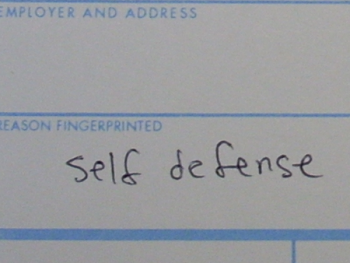
The real problem with concealed carry is that it continues to be a debate about constitutionality and “facts” when, really, it hinges upon one’s individual feelings about the fundamental indecency and helplessness of human beings in a threatening world. And it’s those individual feelings about the personal safety that make CCW unique in the gun-control debate. When CCW proponents claim their rights are being denied, what they’re really claiming is that their feelings are being denied. It’s a communication failure.
And that’s a shame because here is another uncomfortable truth about guns: the total gun ban many seek is not only nearly impossible, it really is unconstitutional. Regardless of what the so-called “Founding Fathers” intended, Americans do have a constitutional right to own guns. No matter how anti-gun one is, the Second Amendment cannot be denied anymore than the First. And much like freedom of speech, the only argument to be had revolves around defining terms. In the CCW case, the tricky words up for debate are “arms” and “bear.” But without an ability to see even some of the opposing side’s actors as reasonable, the two sides are likely to continue to define nothing but their own mutual contempt.
And now Abe Sauer is armed.
5 Things You Are No Longer Allowed To Say On The Internet, As Of Right Now
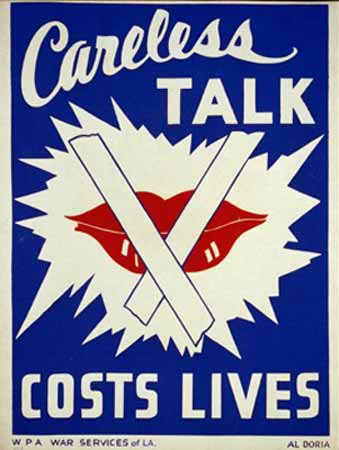
5. “David Foster Wallace is probably a bit overrated.”
4. “People should probably be nicer to each other.”
3. “Something something ‘Godwin’s Law.’”
2. “Something something ‘censorship.’”
1. “Presented without comment.”
Sally Quinn Maybe on the Way Out at 'WaPo'
Sally Quinn is in deep doo, reports Erik Wemple, as in possibly done for, over at the Washington Post, thanks to her latest completely bonkers column about herself.
Old Christian Videos: Amy Grant's "Lead Me On"
by Lindsay Robertson

“Lead Me On” was the title track of the album I’ve always half-jokingly referred to as Amy Grant’s “Dark Album,” but it really is. In the song, Amy sings about slavery, the Holocaust and man’s inhumanity to man. “Lead Me On,” the album, came out in 1988 and was a financial failure, though years later it would be named the best Christian album of all time by CCM (Contemporary Christian Music) Magazine. They were correct.
When “Lead Me On” came out I was 11 and considered myself Amy Grant’s biggest fan. I’d read her unauthorized biography. The only part of it I still remember was about how she got in trouble for saying to the crowd at one of her concerts, “I think we’re all a little bit horny tonight!” I chose her hymn “El Shaddai” as the song I would fail to play recognizably in an ill-advised flute recital that year, and my best friend Sarah and I spent most of our playtime choreographing elaborate dances to songs from Amy’s previous albums, like “Love Will Find a Way,” in the partial hope of one day performing on Star Search.
I was in sixth grade at a tiny unaccredited school in Tallahassee that was owned by a Non-Denominational Charismatic church without a national franchise (just a stand-alone church, basically. This would become a problem later). My favorite activity at that time, other than listening to Amy Grant, was having my parents drop me off at the library where I would spend entire Saturdays reading back issues of Reader’s Digest, copies of which the library provided going back to the 60s. I got all of my information about life from church, the church school, the twenty or so mostly crap YA books I read per week, and Reader’s Digest. Other than the library, I had no friends or influences that were not directly church-related. Even our math books were Christian.
Anyway, on the day “Lead Me On” was released, I was standing at the counter of the old Christian bookstore on Thomasville Road, allowance money in hand, wondering if I could get away with stealing the life-size cardboard stand-up of Amy that advertised the album’s release. I remember jumping in my parent’s Toyota minivan and putting the tape in, and basically being in heaven. This was an album like no other I’d ever heard. It was a Christian album, like all of the other non-classical albums I’d heard, but it was about other stuff too. Like history. And romantic love. This was a revelation.
It’s easy now to make fun of the video and song “Lead Me On.” With the high-tech tools of ironic distance and some-college criticism we have today, a video like this doesn’t stand a chance. Amy Grant is scratching her head and throwing up her hands while singing about slavery? Standing in front of a wind machine in a leather jacket while alluding to the horrors of the Holocaust (“Waiting for the train/labeled with a golden star”)? Today, Amy Grant wouldn’t even be allowed to sing about those things at all, and at the time she kind of wasn’t either, but for different reasons — the album was, again, a failure. Her audience, which was at the time all Christian (this was three years before her mainstream transformation) probably balked at the serious themes the album raised, wishing instead for Amy’s usual mix of upbeat “I love Jesus!” songs and hymns, like “El Shaddai,” that seemed sacred and ancient from the day the album hit the stores. Like many non-denominational churches in the 1980s, we sang “El Shaddai” as a hymn, and often women performed spontaneous interpretive dances to it on stage during the service.
When I watch this video, I get all torn up inside. As someone who makes a living partially from making fun of old videos on YouTube (and don’t we all now?), of course it’s funny. And of course it’s appalling that a pop singer is singing about deep historical wounds felt most strongly by groups to whom she doesn’t belong. (The slaves were “wearing their anger like a ball and chain.” Ugh.) But there’s something else, too. I get goosebumps and chills and little dopamine electrical pleasure zaps watching this video. Every single time. I basically writhe with nostalgic delight. Not just because I realize that this song (and many other Christian rock songs) have been constantly playing on a low level in my head all my life and that I still know all of the words. Because, when it came out, while I’d read about slavery and the Holocaust in books and Reader’s Digest, nobody in my life, not teachers, not anybody, ever spoke about things like that. There was no such thing as social justice as a concept, much less a goal, in the fundamentalist Christian church of the 1980s. (Unless you counted abortion, which, oh boy, they did.)
Amy Grant herself probably laughs at this video now, but I’m sure she’s aware that in its original cultural situation, this song and this album and this video were an act of incredible courage. At the height of her popularity, Grant used it to draw attention to the things nobody in her audience ever talked about, and not just the “bad things our forefathers did or allowed to be done to other human beings” stuff. If the album has one running theme, it’s about doubt, and how doubt is a part of faith, and how faith is really hard, what with all the bad things in the world. “Lead Me On,” the song, is specifically about questioning one’s faith in a God who would allow such atrocities to happen (“Somebody tell me whyyyyyy”), dressed up a little (but only a little) as a song about how people have always depended on God in times of trial. I would lose my own faith in God permanently just a few years later, and my church would fall apart into tiny angry splinters, ruining more than a few families and lives. Amy Grant was right: life is scary and messy, and faith is almost impossible. But at least this video is hilarious.
Lindsay Robertson contributes to many websites, like Jezebel and Vulture, and can also be found here.
New Element Very Heavy
Yay! There’s a new heaviest element! “Copernicum has the atomic number 112 — this number denotes the number of protons in the nucleus of an atom. It is 277 times heavier than hydrogen, making it the heaviest element officially recognized by international union for chemistry IUPAC.” The element was named after astronomer Nicolaus Copernicus, who was best known amongst his contemporaries for his gigantic ass, of which Erasmus Reinhold once quipped, “You could play gin rummy on that thing.”
Video as Publishing: This Is How We Do It
by Eric Spiegelman

A fan of Old Jews Telling Jokes once sent us an email saying he loved the videos but he couldn’t figure out how to print them out and needed our help. How adorably incorrect! Laughter, long sigh. But deep down, this fan’s sentiment is not entirely ridiculous.* A lot of what we see on the Internet is digital publication; usually we can print it out. This notion underlies my grand unified theory of Internet video: treat it like publishing, not film or television, and this will become a viable industry.
Much of the film and television business is based on risk management. Will this show work? Maybe! So why make it? Because it’s based on this book that sold a million copies and it stars Brad Pitt and it’s a murder mystery and we know that murder mysteries are SO HOT right now, especially with teen girls in suburban neighborhoods. Every brand, talent and genre has a particular following, and we have a vague sense of how big that following is and who is in it. And the marketing people in Hollywood, they’re brilliant. They know exactly how to reach these audience pools and how much money to spend doing so. All things considered, if there’s a pretty good shot people will watch a show, and the projected audience is big enough to justify the cost, the project’s a go.
We’ve figured out a few things about Internet video, but so far not enough to justify anything but the smallest risk. We know what the big genres are: technology, gossip, cute things, mommy issues, how-to, awesome, what the fuck-and porn. We know that everything works better with a dash of funny. We’re pretty sure we need to make peace with advertising, though we have great hope for direct sales. We are mostly clueless when it comes to marketing. We have trouble reaching people.
This is where my publishing theory comes in-regarding online publishing, that is. (Just to be clear, we ain’t printing no videos.*) It’s easy to find the exact size of a blog’s readership-there’s a stats page somewhere that tells you. If an editor posts a video to her site, some percentage of her audience will click on it. If you can estimate the traffic, you can estimate how many ad impressions will be delivered and you can estimate revenue. If you can estimate revenue, you can gauge how much to spend on production. You can manage your risk.
The editor provides both marketing and distribution. These two functions do not overlap in film or television. The closest you get is seeing the one-sheets in the theater lobby advertising the movies playing at that theater. But online these can be the same thing. Here’s a video I recommend you watch (promotion), and you click on it (delivery).
Let’s imagine a website with one million unique viewers per week. Its editor, through years of applying the human skill of pattern recognition, knows that 2% of her audience will watch a video she posts. That’s 20,000 people. Now assume an eCPM [effective cost per thousand impressions] of $15 for all the ads in the video stream, and boom, you know with a certain level of certainty that this one video will gross at least $300 in revenue.
You laugh. But that $300 of expected income is the kernel of an industry, because it is predictable. Get your production costs below $300 per episode there’s a good chance you’ll make a profit. (Hint: you’ll need to shoot in bulk.)
And play with the variables. Plenty of websites have more than 1 million uniques a week. When they’re that size they have robust ad sales teams that can get a higher eCPM. And if the show is, you know, actually good, then the percentage of the audience who clicks “play” might be higher.
Then factor in the banner ads that surround a video player widget and the social media aspect of a thousand editors of personal blogs and Twitter feeds and emails spreading the links and embedding the video elsewhere and all that is upside and pretty soon there’s a BONANZA.
Okay, so I’m floating up in the clouds now. But you know what else floats around in the clouds? Moisture. Little molecules of water just hovering around in the sky. If you introduce a single speck of dust up there a few water molecules stick to it and then more will stick to those and suddenly you have a raindrop that brings the whole thing back to earth. (This dust is called “cloud condensation nuclei.” I learned it on Wikipedia.) The millions of people who spend inordinate amounts of time on the Internet are the water molecules in this metaphor. The iota of predictability that an editor can bring to the equation is the speck of dust, the condensation nuclei.
The only way this works is if the editor commits to embed every episode in a series and to a schedule. The only way she’ll do that is if she loves the show. Her publisher isn’t going to make her do it, and the scent of bonanza picked up by the trained nose of the ad sales team will not factor into her decision (that would be unethical). But if she loves the show, and she kicks it to her publisher to hammer out a deal and then over to the ad sales team who sells the shit out of it? Condensation might happen.
So what makes an editor fall in love with a show? Ask her! And pay close attention to her voice, as expressed on her site. Video production is a collaborative art form, and the editor will, one way or another, have a say in the creative. She’s the gatekeeper to an audience. If your key don’t fit, the door won’t open.
Now, a confession. I’ve been trying to do this for two years, pitching independent video series to blog networks and other publications as if they were distributors, and I haven’t got it to work yet. Not in any formal manner, at least. There are probably a ton of reasons for this, not the least of which is that online publishers and Hollywood producers speak two different languages. (“Editor” means something totally different in Hollywood!)
But I’ve seen signs enough to believe that this is doable and that it can work. The point of writing this is the hope that it finds someone who has done it successfully, or that it infects someone’s thinking enough to try it on their own. There’s a saying in Hollywood that nobody wants to be first, but everybody wants to be second. You there, take this idea, make it work, then shoot me an email. I will gladly follow in your footsteps.
*It seems pretty likely that the fan wanted to print out transcripts of the videos, and to this end we recommend he purchase Old Jews Telling Jokes, the book, which is coming this fall from Villard!
Did Eric Spiegelman mention that Old Jews Telling Jokes has a book coming this fall from Villard?
